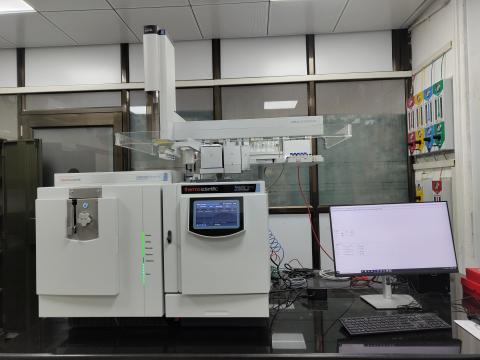| |
|
Gas Chromatography High Resolution Mass Spectrometer
(Orbitrap GC-HRMS )
 Kindly download Material Safety Data sheet and submit the hardcopy of filled sheet along with your sample Kindly download Material Safety Data sheet and submit the hardcopy of filled sheet along with your sample
|
|
| Make |
: Thermo Scientific, USA |
| Model |
: Orbitrap Exploris
|
| Specification |
:- Electron Ionization
- CI Source with Positive Ion Chemical Ionization (PCI) and Negative Ion Chemical Ionization (NCI)
- Triplus RSH smart autosampler
- Orbitrap mass Analyser
- Mass range: m/z 30-3000
- Mass resolution 60,000 at m/z 200
- Available library: NIST, GC Orbitrap contaminants library, GC orbitrap environmental library, GC orbitrap PCBs library, GC orbitrap pesticides, m/z cloud Thermo library.
|
|
 |
|
The Orbitrap is an ion trap mass analyzer that consists of two outer electrodes and a central electrode, which enable it to act as both an analyzer and detector. Ions entering the Orbitrap are captured through "electrodynamic squeezing," after which they oscillate around the central electrode and in between the two outer electrodes. Different ions oscillate at different frequencies, resulting in their separation. By measuring the oscillation frequencies induced by ions on the outer electrodes, the mass spectra of the ions are acquired using image current detection. GC-MS is a technique which combines separation capabilities of GC with detection and identification capabilities of MS. Two ionization modes commonly employed are electron ionization (EI) and chemical ionization (CI). In EI, a beam of high energy electrons emitting from a filament strikes the stream of sample molecules. As a result, ionization takes place. Whereas in CI, the sample molecules collide with a stream of pre-ionized reagent gas causing ionization. In tandem MS (MS/MS or MSn), precursor ions undergo further fragmentation.
|
|
- One sample refers to one injection in any of these modes. Multiple injections of the same sample will be treated as multiple samples.
- Sample Preparation:
- The sample should be dissolved in volatile organic solvents.
- Solvents such as DMSO, THF and water are not acceptable.
- The sample should be free of particulates of size > 0.2 μm
-
Sample Submission: Samples can be sent by courier after finishing the registration process online or can also be submitted in person.
- Analysis results: After the sample analysis is complete, the results will be sent through email.
- The experimental data provided is only for research / development purposes. These cannot be used as certificates in legal disputes.
- The analytes expected in the samples should be clearly indicated and MSDS (Material Safety Data Sheet) should be given both for the samples and the analytes to indicate the toxicity.
|
Contact : 022-2159 6875
Email Id : mngandhi@iitb.ac.in,
gchrms_saif@iitb.ac.in
|
|
GC-LCMS (Orbitrap) Charges excluding GST
|
Using orbitrap MS
detector (CI /EI) 2:5:10 ratio
|
| |
University |
National Lab/R&D's |
Industry |
IIT Bombay Users |
|
| Liquid |
2500/- |
6250/- |
12500/- |
1200/- |
Per Sample |
| Headspace |
3000/- |
7500/- |
15000/- |
1500/- |
Per Sample |
| SPME |
5000/- |
12500/- |
25000/- |
2500/- |
Per Sample |
| Using FID detector |
| Liquid |
1200/- |
3000/- |
6000/- |
600/- |
Per Sample |
| Headspace |
2000/- |
5000/- |
10000/- |
1000/- |
Per Sample |
| SPME |
3000/- |
7500/- |
15000/- |
1500/- |
Per Sample |
|
